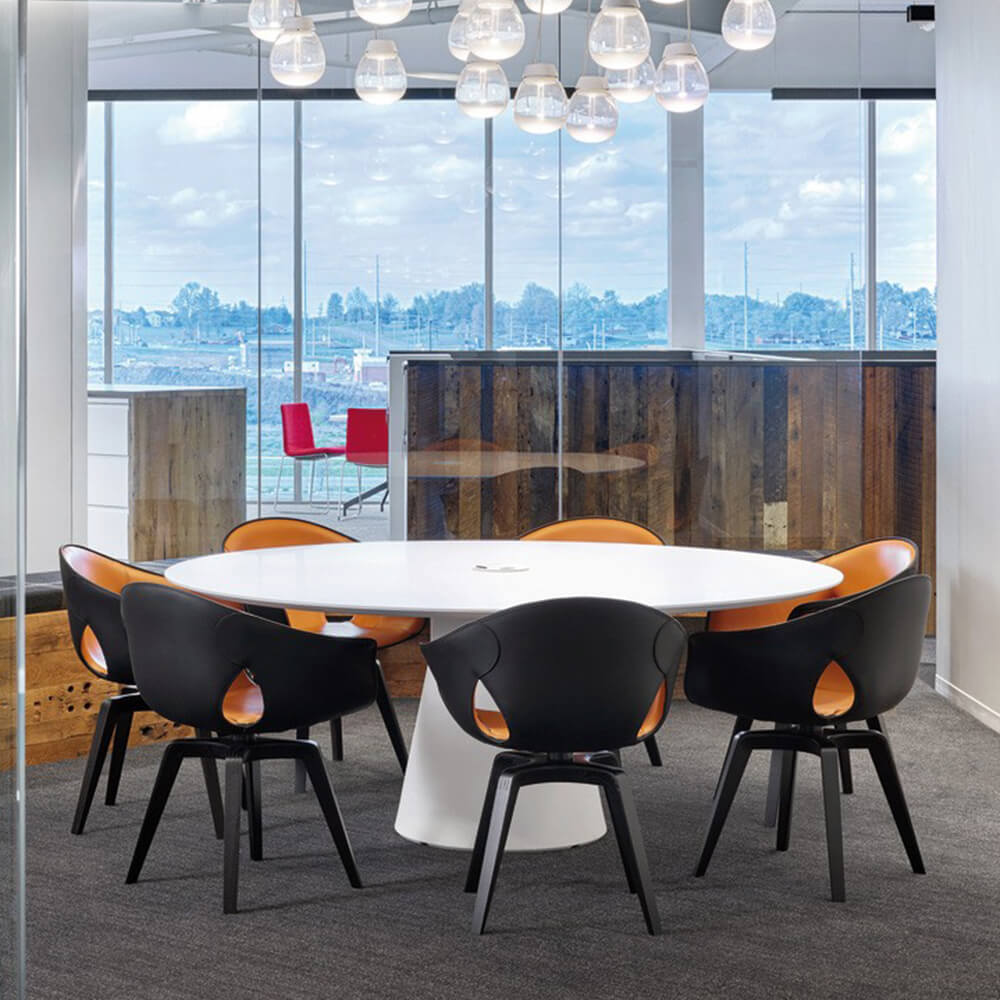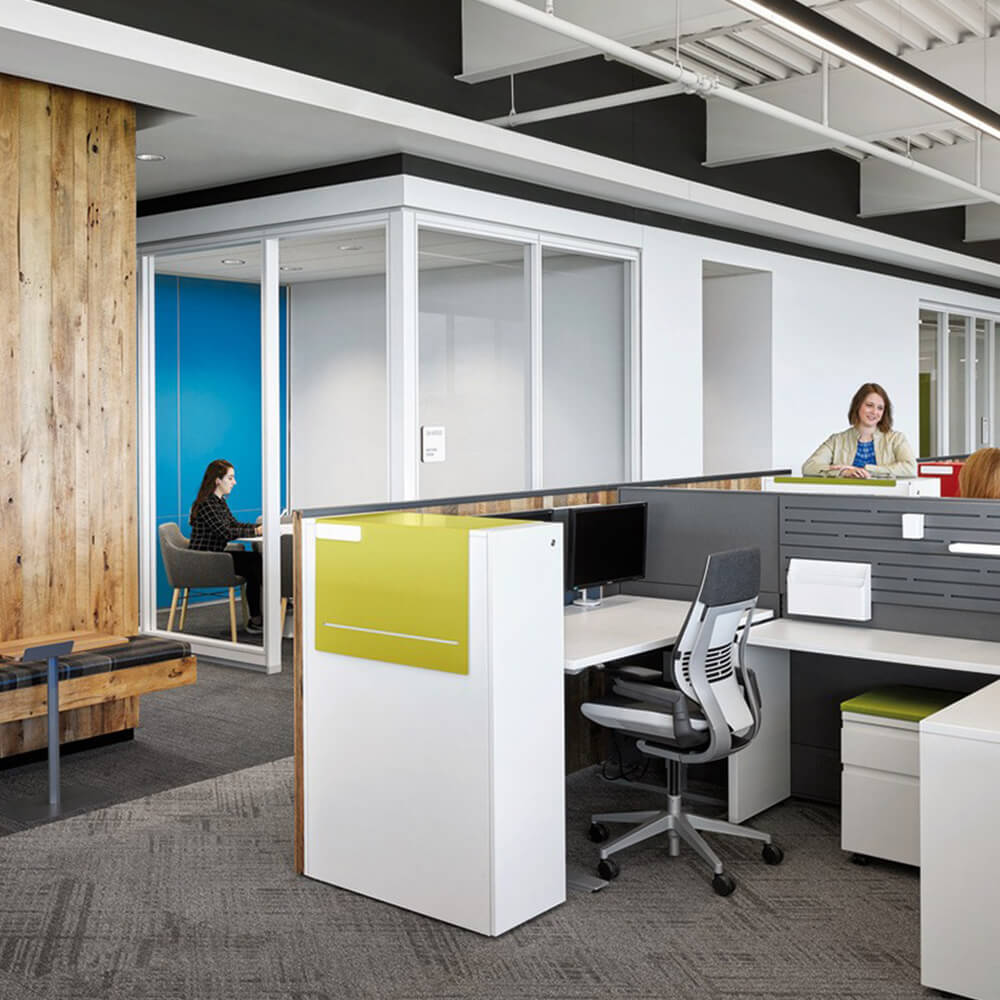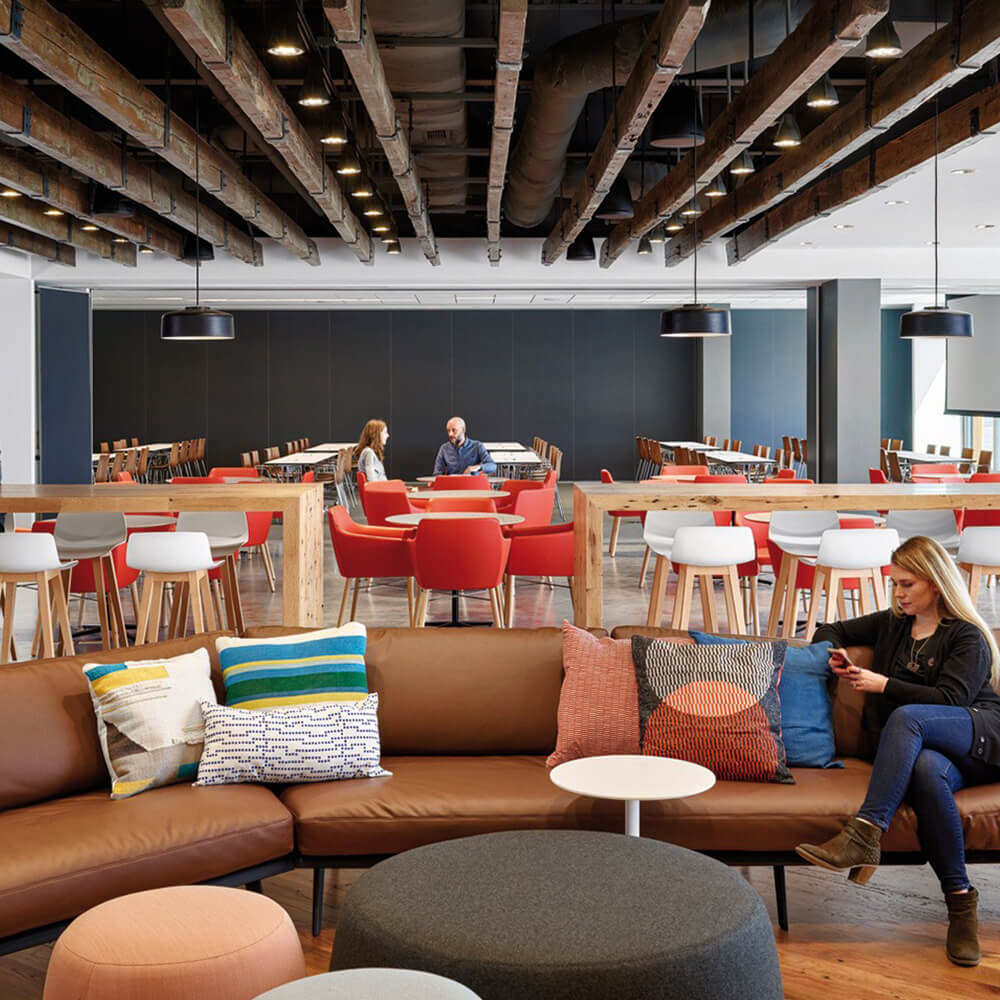July 2019
Designing for Public Spaces
Read more
In our ongoing drive to make corporate design as efficient, worker-friendly, and cost-effective as possible, new trends are constantly emerging. One of the more recent is free addressing, where walled offices and set seating arrangements are eschewed in favor of a mix of different collaborative areas, quiet spaces, and workstations with unassigned desks. This allows employees to move freely from space to space—what’s known as hot-desking—depending on the task they’re engaged in at the time.
On the face of it, this might sound like a variation on the open office. But a free-address design actually more closely resembles a coworking space, with open-access workstations, private and semi-private rooms for solo work, soundproof spaces for making sensitive phone calls, and meeting rooms to accommodate small and large teams.
Prior to founding Golden Thread Agency, a creative collaborative in southern New Hampshire, Karyn Martin was a manager at a mid-size Boston marketing and PR agency, where she helped implement free-address systems. She says, “Hot-desking environments are perfect for businesses that have some remote workers, where not every person is in the office every day. It’s also good for employers who want flexibility for themselves and their personnel.” She notes that this can be especially beneficial for companies that have more than one office and require employees to travel between them. “Knowing you’ll always have a desk, no matter which place you’re in, makes a difference in employee satisfaction,” she says.
First and foremost, they create an “in it together” atmosphere by breaking down walls—literally and figuratively. This leads to a democratic feeling among coworkers, and gives people from different teams or departments a chance to interact more regularly. Free-address office design also reduces visual pollution and makes a space easier to clean by keeping desktops clear of both personal and corporate clutter. And it gives employees the chance to choose the type of space that’s best suited to the work they’re doing, or to their own personal style of working.
Paul, who works for a small HR tech startup, says, “It’s great having a flexible workspace, where I can work privately in a smaller phone booth–type room, as well as conference rooms, and at a desk in an open/shared work floor. It really just depends on what kind of work needs to get done.” He also appreciates having smaller, private rooms for meetings. “It is less formal, and you can just grab a room, instead of shutting someone’s office door.”
For employees like Paul, who enjoy working in varied settings, hot-desking can be an ideal solution to a common problem: a growing workforce, without the corresponding funds to develop a larger real estate footprint. But free addressing is not without its challenges.

“It’s great having a flexible workspace, where I can work privately in a smaller phone booth–type room, as well as conference rooms, and at a desk in an open/shared work floor. It really just depends on what kind of work needs to get done.” — Paul
Disconnection in the office.
Some employees feel less connected in the office—where they spend much of their waking hours—when they don’t have a dedicated space. Sharon works for Verizon, which has converted all of its workspaces in New Jersey and New York to free-address design. She says, “I don’t find it conducive to collaboration. It is often difficult to find a space to sit, and it doesn’t feel comfortable. I don’t feel as productive in these spaces.”
Sharon prefers assigned seating, which she says alleviates the anxiety of having to rush to work just to find a seat. Assigned seats also prevent what she calls “squatting,” where employees retreat to the smaller break-out rooms because they crave comfort or privacy, or a break from the visual and audio distractions that can overwhelm an open office.
Another potential issue: workplace injury.
Sonya Bykofsky, a licensed massage therapist in Lenox, Massachusetts, notes that many clients come to her seeking relief from muscular problems related to poor ergonomics—especially from laptops, a staple of the hot-desking environment.

Sonya Bykofsy advises offering a variety of seating options, especially chairs that can be adjusted for height and lumbar support.
“The small keyboards and screens we have to look down at force us into these contracted positions that are bad for the body,” says Bykofsky. The result? Muscle tension and spasms, and repetitive-stress injuries that can become chronic. Bykofsky recommends that employers who are considering a free-address workspace plan their workstation design around plug-and-play monitors or docking stations that position laptops at eye level, with an external keyboard that keeps the forearms bent at a 90-degree angle. She also advises offering a variety of seating options, especially chairs that can be adjusted for height and lumbar support.
Having dedicated social spaces, with sofas for relaxing, ottomans for resting the feet, and accent tables for holding drinks or snacks, are also important in a free-address office design. These spaces encourage workers to get out from behind their screens, kick back, and interact with their coworkers.

Social spaces, with sofas for relaxing, ottomans for resting the feet, and accent tables are important in a free-address office design.
Because employees can sometimes feel a sense of dislocation when they don’t have a designated desk, a common impulse in a hot-desking environment is to try to claim the same space every day. To prevent this, Martin suggests numbering workstations and providing a sign-up sheet, where employees can register their chosen space for a day or two at a time.
Give employees something for the lack of personalization.
Another key to free-address success is giving employees something in return for the lack of personalization that’s inherent in a more transient style of work. One solution: a check-out system similar to a library, where employees can borrow backrests, ergonomic mice, footrests, noise-canceling headphones, and other tools that improve comfort and enhance productivity.
But, says Martin, for a free-address design to succeed, it’s not just about work output. “I’d like to see companies get really creative with this,” she explains. “Maybe allow employees to put the office goldfish bowl on their desk for the day, or check out action figures, plants, or a couple of small decorations—little things that make their spaces feel more personal. When we give employees something fun they can look forward to, it enhances company culture and happiness.”